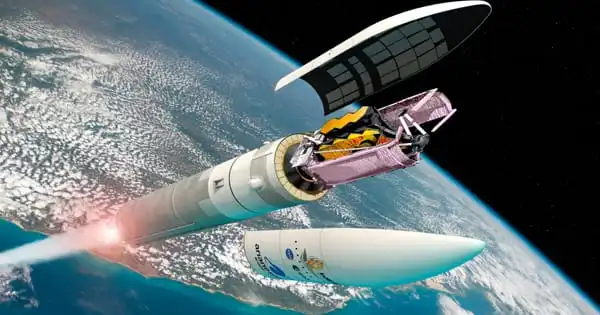The growing interest in deep-space exploration has created a demand for powerful, long-lasting rocket systems to propel spacecraft through the cosmos. Scientists have created a miniature version of a Hall thruster propulsion system that extends the lifespan of the rocket while producing high power.
The growing interest in deep-space exploration has created a demand for powerful, long-lasting rocket systems to propel spacecraft through the cosmos. Scientists at the U.S. Department of Energy’s (DOE) Princeton Plasma Physics Laboratory (PPPL) have created a tiny modified version of a plasma-based propulsion system known as a Hall thruster that both extends the rocket’s lifetime and produces high power.
The plasma-powered miniaturized system measures less than an inch in diameter and eliminates the walls around the plasma propellant to create innovative thruster configurations. Plasma is a state of matter composed of free-floating electrons and atomic nuclei, or ions. Among these breakthroughs are the cylindrical Hall thruster, which was first proposed and investigated at PPPL, and a fully wall-less Hall thruster. Both configurations reduce channel erosion caused by plasma-wall interactions, which limits thruster lifetime – a major issue for traditional annular, or ring-shaped, Hall thrusters, and especially for miniaturized low-power thrusters used on small satellites.
In the last two years, we published three papers on new physics of plasma thrusters, which led to the dynamic thruster described in this paper. It describes a novel effect that bodes well for future developments in this field.
Professor Raitses
Widely studied
PPPL physicists Yevgeny Raitses and Nat Fisch invented cylindrical Hall thrusters in 1999, and they have been studied with students on the Laboratory’s Hall Thruster Experiment (HTX) since then. The PPPL devices have also been studied in countries such as Korea, Japan, China, Singapore, and the European Union, with plans to fly them in Korea and Singapore.
While wall-less Hall thrusters can reduce channel erosion, they suffer from extensive widening or divergence of the plasma thrust plume, which degrades system performance. To address this issue, PPPL has implemented a key innovation in the form of a segmented electrode, a concentrically joined carrier of current, on its new wall-less system. This innovation not only reduces divergence and helps to intensify rocket thrust, but it also suppresses the hiccups of small-size Hall thruster plasmas, which disrupt the smooth delivery of power, according to Raitses.
The new findings are the culmination of a series of papers co-authored by Jacob Simmonds, a graduate student in the Princeton University Department of Mechanical and Aerospace Engineering, and Raitses, his doctoral co-adviser; PPPL physicist Masaaki Yamada is the other co-adviser.

“In the last two years, we published three papers on new physics of plasma thrusters, which led to the dynamic thruster described in this paper,” said Raitses, who directs PPPL’s research on low-temperature plasma physics and the HTX. “It describes a novel effect that bodes well for future developments in this field.”
The use of segmented electrodes in Hall thrusters is not novel. Previously, Raitses and Fisch used such electrodes to control the plasma flow in conventional annular Hall thrusters. However, the effect measured and described by Simmonds in his recent paper in Applied Physics Letters is much stronger and has a greater impact on overall thruster operation and performance.
Focusing the plume
The new device addresses the issue with wall-less Hall thrusters, which allow plasma propellant to shoot from the rocket at wide angles while contributing little to the rocket’s thrust. “In short, while promising, wall-less Hall thrusters have an unfocused plume due to the lack of channel walls,” Simmonds said. “As a result, we needed to figure out how to focus the plume in order to increase thrust and efficiency and make it a better overall thruster for spacecraft.”
To shape the plasma and narrow and improve the focus of the plume, the segmented electrode diverts some electric current away from the thruster’s high-voltage standard electrode. This effect is achieved by changing the directions of the forces within the plasma, particularly those on the ionized xenon plasma that the system accelerates to propel the rocket. Ionization converted the process’s xenon gas into free-standing electrons and atomic nuclei, or ions.
These advancements increased thrust density by shaping more of it in a smaller volume, which is a key goal for Hall thrusters. The segmented electrode has also reduced plasma instabilities known as breathing mode oscillations, “where the amount of plasma increases and decreases periodically as the ionization rate changes with time,” according to Simmonds. Surprisingly, he added, the segmented electrode eliminated these oscillations. “For these reasons, segmented electrodes are very useful for Hall thrusters,” he explained.





